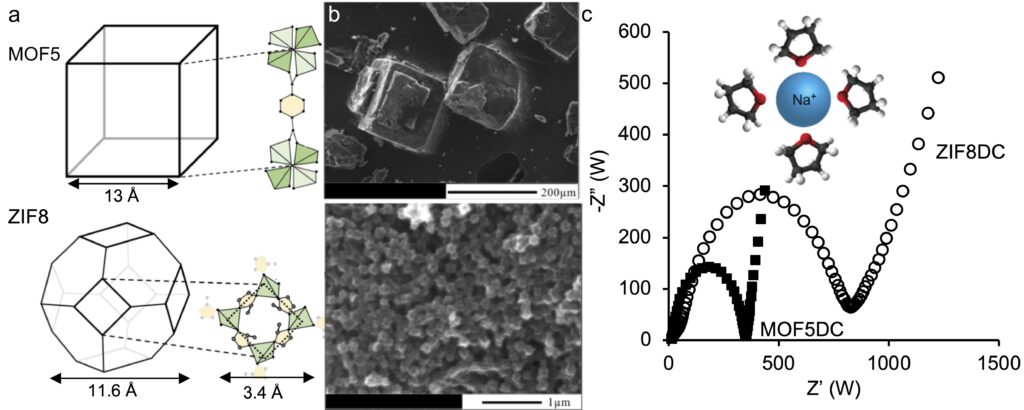The development of low-cost energy storage technologies is of critical importance for large-scale implementation of renewable energy, including wind and solar power. Sodium-ion batteries are a promising, low-cost alternative to lithium-ion batteries with great potential for grid-scale energy storage, however widespread implementation of sodium-ion batteries is currently limited by a lack of low cost, high energy density anode materials.
Our research group is currently exploring two different types of carbon as high-performance, low cost anode materials for sodium-ion batteries: 1) Metal organic framework-derived carbons, and 2) Utah coal char.
Metal Organic Framework-Derived Carbon (MOFDC) Anodes
MOFDCs have great potential as electrochemical energy storage materials due to their large surface areas and highly tunable pore structures. In this work, two MOFDCs are tested as sodium-ion battery anode materials and their charge storage mechanisms compared. MOF5 (Zn4O(1,4-benzodicarboxylate)3) and ZIF8 (Zn(2-methylimidazole)2) were used as sacrificial templates and pyrolyzed to yield highly porous, structurally-robust carbons with high surface areas (MOF5DC and ZIF8DC).Half-cell discharge tests at C/2 attain capacity values of 227 and 107 mAh/g for MOF5DC and undoped ZIF8DC, respectively. Cycling stability testing confirms the structural robustness of the MOFDC materials, with the anodes retaining between 84-89% capacity over 66 cycles. Discharge profiles for both materials indicate that the primary storage mechanism of MOF5DC and ZIF8DC anodes is adsorption at defect sites. A comparison of half-cell discharge, cycling rate, and electrochemical impedance spectroscopy measurements suggests that MOF5DC also demonstrates some nanopore filling mechanisms.
Utah Coal Char Anodes
Battery anodes made from coal char represent an exceptional opportunity for Utah coal, as evidenced by a price comparison of Utah coal raw material costs (approximately $0.01-$0.03/kg) with the value of commercial carbon battery anodes (approximately $12.50/kg). Char is a constituent of lignite, sub-bituminous, and bituminous-type coals, and is a complex mixture of ash, hydrocarbons, and hard carbons. While coal tar (liquid component of pyrolyzed coals) has been used commercially as an anode material for lithium-ion batteries, current applications of coal char are largely limited to energy production by combustion. In this research, our group is determining optimal processing conditions to maximize the capacity of Utah coal char-derived carbons in sodium-ion batteries. Results to-date indicate capacities approaching that of “well-designed” carbon anodes, including MOFDCs.
Highlights:
- Examined the sodium-ion storage mechanisms of two metal organic framework (MOF)-derived carbons (DCs) with vastly different structures.
- Undoped ZIF8DC was tested for the first time as a sodium-ion battery anode material.
- First investigations of acid washing and pyrolysis conditions on the sodium-ion battery anode capacity of Utah coal char.
Publications & Presentations:
- Zahra Karimi, Jaron Moon, Chanel Van Ginkel, Douglas Pedersen, Joshua Malzahn, Eric Eddings, and Roseanne Warren, “Bituminous coal char-derived hard carbon as a low-cost anode material for sodium-ion batteries,” Proceedings of the 239th ECS Meeting, Online meeting, May 2021 (Oral presentation).
- Nolan Ingersoll, Zahra Karimi, Dhruv Patel, Robert Underwood, and Roseanne Warren, “Metal Organic Framework-Derived Carbon Structures for Sodium-Ion Battery Anodes,” Electrochimica Acta, 297, pp. 129-136, 2019. DOI: 10.1016/j.electacta.2018.11.140.
Funding: University of Utah Research Incentive Seed Grant; NSF Award #1742696.
a) Structure and composition of MOF5- and ZIF8-derived carbons. Top: MOF5 cubic structure consisting of repeating units of Zn4O nodes connected by 1,4-benzodicarboxylic acid struts. Bottom: ZIF8 structure consisting of Zn ions coordinated by four imidazolate rings. b) SEM images of MOF5DC (top) and ZIF8DC (bottom) . c) Electrochemical impedance spectroscopy measurements of MOF5DC and ZIF8DC anodes.

Charge-discharge profiles of MOFDC anodes. Voltage profiles (1 , 5 , and 10 cycles) of MOF5DC (a) and ZIF8DC (b) half cells (cycle 1 = dotted; cycle 5 = dashed; cycle 10 = solid). c) Differential capacity vs. half-cell voltage for MOF5DC (dotted) and ZIF8DC (solid) cycle 5 charge/discharge profiles.
 a) Utah coal is classified as a bituminous coal with a medium-high carbon content. b) Coal consists of three main components: volatiles, tar, and char (including solid hydrocarbons and ash). c) Replacing fossil fuel applications of Utah coal char with battery applications has benefits for grid-scale renewable energy storage and the Utah coal industry.
a) Utah coal is classified as a bituminous coal with a medium-high carbon content. b) Coal consists of three main components: volatiles, tar, and char (including solid hydrocarbons and ash). c) Replacing fossil fuel applications of Utah coal char with battery applications has benefits for grid-scale renewable energy storage and the Utah coal industry.

